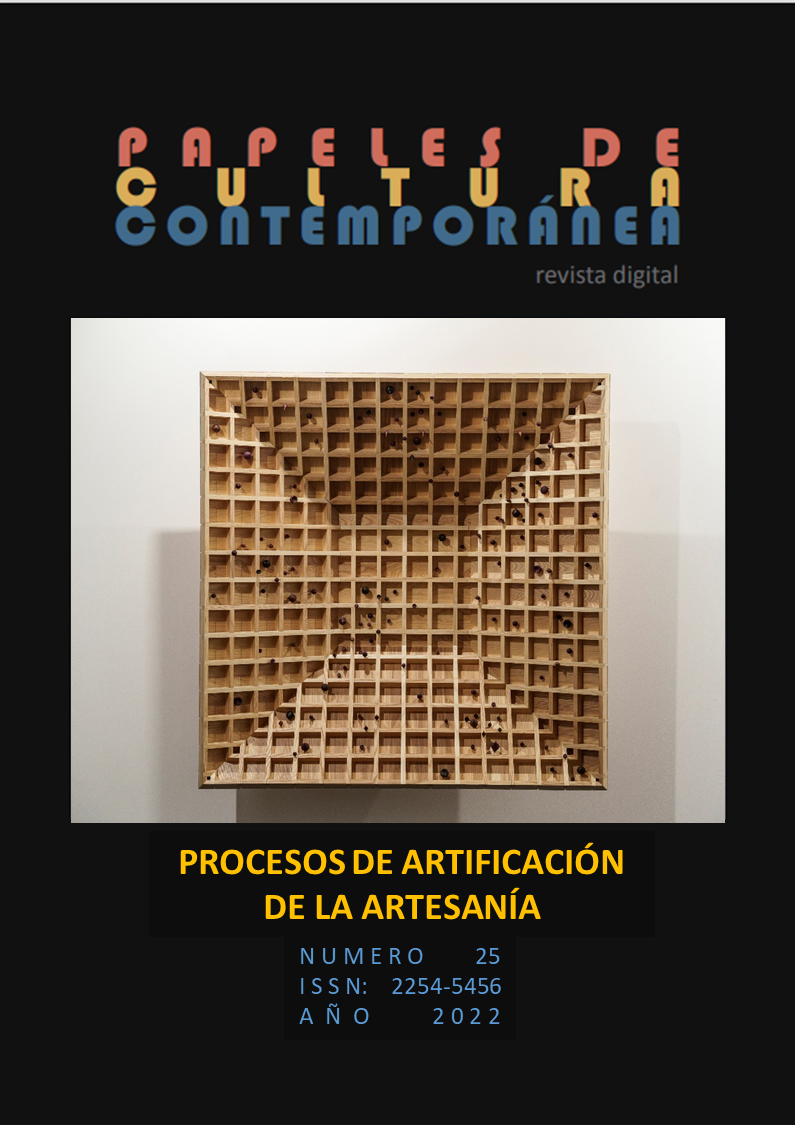Who can erase the traces?
The intervention of public space by Latin American artists
DOI:
https://doi.org/10.30827/pcc.25.2022.28648Keywords:
Performance, Public space, Latin Amercan art, Artistic interventions, Women artistAbstract
From various and particular operations, Latin American artists have built a creative corpus where their own body has become the axis of inquiry and (re)discovery of new questions and languages, taking the public space as the stage for their actions. Placing and exposing the body, making use of new strategies to discuss issues of its context and its genre, from the symbolism of natural elements such as water, blood and earth, has become the artistic and theoretical support of important creators. An approximation towards the meanings, the connotation and the transcendence that the action of creative women has had in the public space, from its direct location from the body as a distinctive note of Latin American art in recent decades, constitutes the line of focus of the present trial.
Downloads
References
ACCONCI, V. (1995) «Espacio público en un tiempo privado», conferencia presentada durante el seminario PUENTE…de pasaje, Bilbao, 27-28 de octubre de 1995.
ALBARRÁN, J. (2019) Performance y arte contemporáneo: Discursos, prácticas, problemas. Madrid: Ediciones Cátedra.
ALCÁZAR, J. (2001) «Mujeres y performance: el cuerpo como soporte», ponencia presentada en Latin American Studies Association LASA, XXII International Congress, Washington DC, septiembre.
ALIAGA, J. V. (2006) «La elocuencia política del cuerpo. Bibliografía sobre Performance» Exit Book: revista de libros de arte y cultura visual, 5, págs. 60-75.
BLANCO, P., CARRILLO, J., CLARAMONTE, J. y EXPÓSITO, M. (eds.) (2001) Modos de hacer: arte crítico, esfera pública y acción directa. Salamanca: Ediciones Universidad de Salamanca.
CAMNITZER, L. (1994) New art of Cuba. Austin, University of Texas Press, 1994.
CORVALÁN, K. (2012) Artistas latinoamericanas: un recorrido por diálogos conceptuales. Ediciones Artecubano, Consejo Nacional de Artes Plásticas y Banco del Alba, La Habana.
ESPINOSA DELGADO, M. (2003) «La estética del sacrificio: rituales de sangre desde el arte hasta el asesinato». Artecubano: revista de artes visuales, 1, pp. 60-73.
FUSCO, C. (2004) «Pensamientos introductorios sobre el performance latinoamericano y la reconquista del espacio público», en: BARRAGÁN, P.: No lo llames performance, Domus Artium, pp. .35-43.
GARBAYO, M. (2016) Cuerpos que aparecen: performance y feminismos en el tardofranquismo. Bilbao: Consonni.
GIUNTA, A. (2018) Feminismo y arte latinoamericano. Historias de artistas que emanciparon el cuerpo. Buenos Aires: Siglo Veintiuno Editores.
HERRERA YSLA, N. (2016) «Acciones, performances y actitudes en el arte contemporáneo cubano», en Performance, acciones y activismo. Errata no.15 - Revista de Artes Visuales, Colombia, pp.42-62
LÓPEZ-CABRALES, M. «Laberintos corporales en la obra de Ana Mendieta». Espéculo. Revista de estudios literarios. Universidad Complutense de Madrid. (Disponible en línea: https://webs.ucm.es/info/especulo/numero33/laberint.html). Fecha de consulta: 30/04/2020.
RAMÍREZ, J. A. (2003) Corpus Solus. Para un mapa del cuerpo en el Arte Contemporáneo, Editorial Siruela.
SANTANA, A. (2019) «Un arte público en ciernes. Un diálogo sobre arte e intervenciones públicas en la Cuba contemporánea», en GRENIER, C. y HERNANDEZ, H. E. (eds.) Pan Fresco. Textos críticos en torno al arte cubano, Almenara Press, Leiden / Reinbeckhallen Foundation, Berlín, pp.301-339.
WALDMANN, J. (2020) «Charla con Regina José Galindo: “No soy una mujer vulnerable”». (2018) (Disponible en línea: https://amlatina.contemporaryand.com/es/editorial/regina-jose-galindo/) Fecha de consulta: 3/05/2020
WILSON, J. (1980) «Ana Mendieta Plants Her Garden». The Village Voice (Nueva York), 13-19 de agosto 1980
Downloads
Published
How to Cite
Issue
Section
License

This work is licensed under a Creative Commons Attribution-NonCommercial 4.0 International License.
Los nombres y direcciones de correo-e introducidos en esta revista se usarán exclusivamente para los fines declarados por esta revista y no estarán disponibles para ningún otro propósito u otra persona.
Los autores y autoras poseen los derechos sobre sus trabajos. Se ruegan que se haga constar la publicación en los mismos si aparecieran con posterioridad en otro medio.












